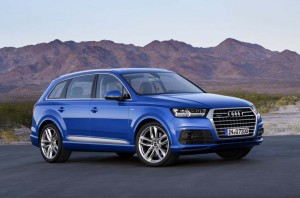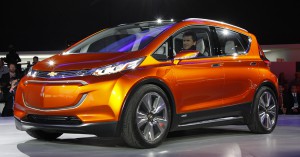
Audi hasn't said whether it will use long-range battery in a new SUV or an existing model like this 2016 Q7.
Audi has launched an effort to develop a battery that can deliver “more than” 500 kilometers, or at least 312.5 miles per charge. The technology would be used in an all-electric SUV, the maker says, though the technology could have application in other Audi vehicles.
The project involves Korean partners Samsung SDI and LG Chem, the latter already working on longer-range batteries with other manufacturers such as General Motors and Nissan.
“This will allow us to supply a technological solution that makes electric cars even more attractive for our customers,” said Dr. Bernd Martens, Member of the Board of Management overseeing procurement at Audi AG.
Along with cost, range is considered one of the Holy Grails for the electric vehicle market. With the exception of the Tesla Model S, virtually all of the battery cars on the market today can barely manage 100 miles, or 160 km, on a charge, some significantly less than that. As skeptics often note, that’s like starting out with a gas tank near empty, even when fully charged.
Tesla says it has managed to reach around 300 miles with a new P90 version of its Model S, though it is waiting to receive official EPA certification.
(Tesla launching new stock offering to raise cash needed for product development. Click Here for that breaking news.)
How much range is enough for potential buyers is a matter of debate. Some proponents insist that 100 miles is enough for the average American to handle daily tasks, but that leaves little room for emergencies, such as getting home to take care of a sick child and then returning to work. Pushing above 200 miles is closer to what a typical gas powered vehicles gets on a full tank.
General Motors is currently working up an all-new, pure battery-electric vehicle, or BEV, dubbed the Chevrolet Volt, which will get about 200 miles per charge. Nissan, meanwhile, has confirmed an earlier report on TheDetroitBureau.com that it will deliver an extensive increase in the range of the next-generation Leaf. That all-electric model currently manages less than 100 miles under optimum conditions.
(Gas-powered cars could soon become the exception if new California rules go into effect. Click Here for the story.)
Getting additional range can be as simple as adding more batteries. The Tesla Model S was designed to house its lithium-ion cells in a sandwich construction under the floorboards. Others use large packs mounted in the traditional engine compartment or in the luggage area.
Part of the challenge is downsizing next-generation batteries to squeeze more energy into a smaller space, as Nissan is doing with the next Leaf, and GM has done with the second-generation Chevrolet Volt plug-in hybrid. That has allowed it to boost range in battery mode to 50 miles while adding space for a fifth passenger.
Opting for a big SUV is one way to ensure enough space for a large battery pack, as Audi appears to be doing. The downside is that weight is the enemy of range, much as it limits fuel economy. So, it remains to be seen if Audi will also take steps to reduce the mass of the new battery-ute.
German luxury rival BMW is reportedly working on at least one, possibly two electric utility vehicles, one of which would go into the same new sub-brand marketing battery models such as the little i3 city car and the i8 plug-in sports car. Those models have enhanced performance and range thanks to the extensive use of lightweight carbon fiber.
(For more on BMW’s plans to add battery-cars, Click Here.)
Audi is already working on several other battery-electric and plug-in vehicles. That includes a version of its R8 supercar. The technology under development with Samsung and LG could help there to not only drive more range but enhance performance.
Contrary to conventional wisdom, electric vehicles can deliver incredible acceleration if tuned for it. A new version of the Tesla Model S, using its “Luuudicrous Mode,” will be able to launch from 0 to 60 in just 2.8 seconds.
Cost is the other issue the auto industry has to deal with. And the more batteries, the more expensive the vehicle. The good news for both carmakers and car buyers is that cost is slipping rapidly. It averaged about $1,000 a kilowatt/hour when work began on the Chevrolet Volt — a hefty penalty for a small car with a 16.5 kw/h lithium pack. The number is believed to now b closer to $400 and some are targeting $200 a kw/h by decade’s end.


Hydrogen fuel cells are likely to make battery powered EVs obsolete in less than five years.
I really like hydrogen for everything! Just as battery evs have infrastructure shortage for for their energy systems. In this corporate world of companies seeking revenue streams to tie the consumer to the corporation forever. The developement of batteries and the ability to fill up at your house anywhere with solar panels without having huge costs makes sense more cost effective at time of development. Making to make hydrogen from natural gas or or atomic energy say much for decentralized energy production unless one belives in corporate mentality. Right now solar is kicking butt on coal with the number of coal companies declaring bankruptcy. Even atomic energy is running scared with the low costs of solar. Solar already powers ups Honda’s hydrogen station. I can afford solar to fill my battery ev. I cant afford to a a hydrogen station at my house. So until they reduce the cost of making hydrogen I stick with battery ev as the batteries get better my solar panels on my roof look better and better than paying some corpration my hard earned dollars.
All this money and effort is being invested in EVs that few people want but the car companies are desperate to sell because they can not meet the 54.5 mpg CAFE standards. This looks a lot light gasohol which benefits a few at a huge cost to many.